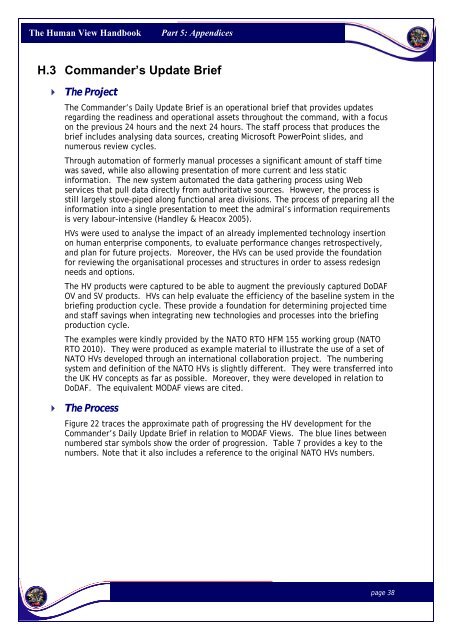The Human View Handbook for MODAF: Part V â Appendices
The Human View Handbook for MODAF: Part V â Appendices
The Human View Handbook for MODAF: Part V â Appendices
Create successful ePaper yourself
Turn your PDF publications into a flip-book with our unique Google optimized e-Paper software.
<strong>The</strong> <strong>Human</strong> <strong>View</strong> <strong>Handbook</strong><br />
<strong>Part</strong> 5: <strong>Appendices</strong><br />
H.3 Commander’s Update Brief<br />
<strong>The</strong> Project<br />
<strong>The</strong> Commander’s Daily Update Brief is an operational brief that provides updates<br />
regarding the readiness and operational assets throughout the command, with a focus<br />
on the previous 24 hours and the next 24 hours. <strong>The</strong> staff process that produces the<br />
brief includes analysing data sources, creating Microsoft PowerPoint slides, and<br />
numerous review cycles.<br />
Through automation of <strong>for</strong>merly manual processes a significant amount of staff time<br />
was saved, while also allowing presentation of more current and less static<br />
in<strong>for</strong>mation. <strong>The</strong> new system automated the data gathering process using Web<br />
services that pull data directly from authoritative sources. However, the process is<br />
still largely stove-piped along functional area divisions. <strong>The</strong> process of preparing all the<br />
in<strong>for</strong>mation into a single presentation to meet the admiral’s in<strong>for</strong>mation requirements<br />
is very labour-intensive (Handley & Heacox 2005).<br />
HVs were used to analyse the impact of an already implemented technology insertion<br />
on human enterprise components, to evaluate per<strong>for</strong>mance changes retrospectively,<br />
and plan <strong>for</strong> future projects. Moreover, the HVs can be used provide the foundation<br />
<strong>for</strong> reviewing the organisational processes and structures in order to assess redesign<br />
needs and options.<br />
<strong>The</strong> HV products were captured to be able to augment the previously captured DoDAF<br />
OV and SV products. HVs can help evaluate the efficiency of the baseline system in the<br />
briefing production cycle. <strong>The</strong>se provide a foundation <strong>for</strong> determining projected time<br />
and staff savings when integrating new technologies and processes into the briefing<br />
production cycle.<br />
<strong>The</strong> examples were kindly provided by the NATO RTO HFM 155 working group (NATO<br />
RTO 2010). <strong>The</strong>y were produced as example material to illustrate the use of a set of<br />
NATO HVs developed through an international collaboration project. <strong>The</strong> numbering<br />
system and definition of the NATO HVs is slightly different. <strong>The</strong>y were transferred into<br />
the UK HV concepts as far as possible. Moreover, they were developed in relation to<br />
DoDAF. <strong>The</strong> equivalent <strong>MODAF</strong> views are cited.<br />
<strong>The</strong> Process<br />
Figure 22 traces the approximate path of progressing the HV development <strong>for</strong> the<br />
Commander’s Daily Update Brief in relation to <strong>MODAF</strong> <strong>View</strong>s. <strong>The</strong> blue lines between<br />
numbered star symbols show the order of progression. Table 7 provides a key to the<br />
numbers. Note that it also includes a reference to the original NATO HVs numbers.<br />
page 38
















